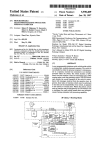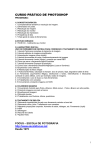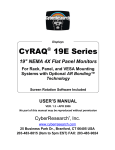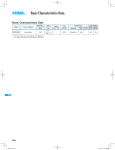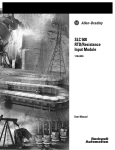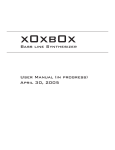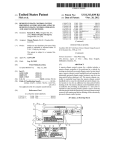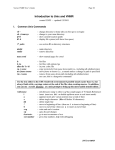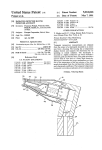Download Circuit and method for determining membership in a set during a
Transcript
USO05295229A United States Patent [191 [11] Patent Number: Viot et al. ' [45] [54] CIRCUIT AND METHOD FOR Assistant Examiner-Tan'q R. Ha?z Attorney, Agent, or Finn-Elizabeth A. Apperley [21] Appl. No.: 899,975 [58] [57] Jun. 17, 1992 Int. Cl.5 ............................................ .. G06F 15/18 US. Cl. ............... ....................... .. 395/51; 395/3; 395/11; 395/900 Field of Search ..................... .. 395/3, 51, 900, 11, 395/61 [56] References Cited U.S. PATENT DOCUMENTS 4,694,418 9/1987 4,716,540 12/1987 4,860,243 8/1989 Ueno et al. .. 5,136,685 8/1992 Nagazumi Yamakawa . . . . . . . . . . . . .. 395/3 .... .. 395/3 . . . . . . .. . . . . . .. 395/3 395/61 Hisano .................... .. 395/51 5,179,634 1/1993 Matsunaga et a1. . 5,189,636 2/1993 ABSTRACT A circuit (14) and method which determine a degree of membership of an input in a membership set during a fuzzy logic operation. The degree of membership is calculated by a single “MEM” software instruction. The MEM instruction determines whether the system input has a degree of membership of zero, of a satura tion level, or of some value in between. An operand assignment circuit (50) and an ALU (56) allow circuit (14) to determine the degree of membership more quickly. Assignment circuit (50) determines a multiplier Ueno et a]. ........................... .. 395/3 5,148,977 9/ 1992 Hibino et al. 5,165,011 11/1992 “Creating Fuzzy Micros” in the Dec. 1991 issue of Embedded Systems Programming, vol.v4, No. 12, pp. 1-10, written by James M. Sibigtroth. User’s Manual entitled “FF-3000 Digital Fuzzy Proces sor User's Manual” published by Omron Corporation. Primary Examiner-Michael R. Fleming [73] Assignee: Motorola, Inc., Schaumburg, Ill. ‘ Mar. 15, 1994 the Apr. 1992 issue of AI Expert, vol. 7 No. 4, pp. 25 [75] Inventors: .1. Greg Viot, Austin; James M. Sibigtroth, Round Rock; James L. Broseghini, Austin, all of Tex. [51] [52] Date of Patent: through 31, written by James M. Sibigtroth. DETERMINING MEMBERSHIP IN A SET DURING A FUZZY LOGIC OPERATION [22] Filed: 5,295,229 395/51 Patti et a1. ......................... .. 364/786 for a multiplication operation based on a number of signi?cant bits in the values to be multiplied. If the multiplier is smaller than the multiplicand, shorter mul tiplication operations may be performed. Additionally, ALU (56) operates in a split mode of operation which is able to perform two eight bit subtraction or multiplica tion Operations concurrently which also results in these operations being performed more efficiently. OTHER PUBLICATIONS “Implementing Fuzzy Expert Rules in Hardware” in 17 Claims, 7 Drawing Sheets EXTERNAL BUS INTERFACE INTERNAL MEMORY CONTROL UNIT 20 :2 52 :2 we TIMING CIRCUIT 22 SEQUENCER 33 Q INSTRUCTION DECODE L 0610 & MICRO ROM CONTROL BUS CONTROL LOGIC CLOCK OSCILLATOR 2-4 POWER CIRCUIT CPU lg 0801 osc2 vDD US. Patent 5,295,229 Sheet 1 of 7 Mar. 15, 1994 DEGREE OF “MEMBERSHIP VERY C0oL ‘00 2'0 3'0 4'0 HOT WARM WARM 5'0 - 6'0 68' 7'0 8'0 9'0 100 SYSTEM INPUT V FIG.1 i" / / \\// //\\ \ / - / lDELTA 1‘ * SLOPE 1 I . l _ I | ‘FF ______ 05km]; SLOPE 2 SLOPE 1 _ SLOPE 2 / \ $00 POINT 1 x DELTA 1 V FIG.2 POINT‘ 2 DELTA 2" ~ US. Patent Mar. 15, 1994 Sheet 2 of '7 ‘5,295,229 EXTERNAL ADDRESS QZHE. E50 AEI WIN . mm, A E\ MM mm noSQmmE2E8 @m2.05: m.m?2%“8. E2 E0N. 1ZJ|.2<E15H mzoaHhswpmz 083 :29a; 6528‘ Hz: EQDSm 4052 oH oA ‘H * mmP 1 zo?bouxm PHZD> A. 3.3% .m.AUNB 2 US. Patent Mar. 15, 1994 Sheet 7 of 7 m ' 5,295,229 1 - IF UPPER, 4‘ BITS OF DELTA 1=SD, ' DECQDE HEM THEN Z1 FLAG IS ASSERTED IF UPPER 4 BITS OF DELTA 2=$D, THEN Z3‘ FLAG IS ASSERTED USE INDEX REGISTER TO ACCESS FIRST PAIR OF 1 IF z1=1. DELTA 1 IS WLTIPLIER 1 ELSE, SLOPE 1 Is MULTIPLIER 1 _ MEMBERSHIP FUNCTION OPERANDS _ mo SLOPE 1 Is “ULTIPLICAND 1 (READ POINT 1 AND POINT 2) 1 INCREMENT ADDRESS IN INDEX REGISTER BY TWO CONCURRENTLY CALCULATE: ~ AND DELTA 1 IS NuLIIPLIcAND 1 IF Z3=1, DELTA 2 IS NULTIPLIER 2 AND SLOPE 2 IS NULTIPLIER 2 ELSE, SLOPE 2 IS NULTIPLIER 2 AND DELTA 2 E WLTIPLICAND 2 DELTA 1=SYSTEM INPUT — POINT 1 I DELTA 2=PDINT 2 - SYSTEM INPUT I CONCURRENTLY MULTIPLY: DELTA 1 x SLOPE 1, AND ‘DELTA '2 x SLOPE 2 STORE DELTA 1 AND DELTA 2 VALUES IN DELTA REGISTER 6O SET SATIRATION FLAGS: I SHIGH=1 IF A1 # 81> FF OR IF Z1=Z2=0 SLOW =1 IF A2 * S2) FF OR IF Z3=Z4=0 ‘ SET JAM rues: JHIGH=1 IF ZP2=1 AND SLOPE 1= 00 Jun’ =1 IF ZP4=1 AND SLOPE 2= 00 1 IF smH=sL0w =1, THEN RESULT=$FF MEMBERSHIP FUNCTION OPERANDS IE (READ SLOPE 1 AND SLOPE 2) 4 ELSE RESULT’ A2 * 52 v v STORE RESULT IN INCREMENT ADDRESS IN INDEx REGISTER BY TWO INTERNAL MEMORY 32 18 Y ES ELTA 1(0? DATA BUFFER 42 TO ‘0 FORCE RESULT IN 0] 1 IS DELTA 2(0? N0 A FORCE RESULT IN DATA BUFFER 42 TO ‘00 Fl 8 1 5,295,229 2 Expert Rules in Hardware” by James M. Sibigtroth. CIRCUIT AND METHOD FOR DETERMINING MEMBERSHIP IN A SET DURING A FUZZY LOGIC OPERATION CROSS REFERENCE TO RELATED APPLICATION This application is related to a copending patent ap plication ?led concurrently herewith and entitled: “A CIRCUIT AND METHOD FOR EVALUATING s. . 0 FUZZY LOGIC RULES” by I. Greg Viot et al., Ser. No. 07/899,968. FIELD OF THE INVENTION This invention relates generally to a data processing system, and more particularly to execution of a fuzzy logic operation in a data processing system. BACKGROUND OF THE INVENTION Data processors have been developed to function as binary machines whose inputs and outputs are either interpreted as ones or zeroes, and no other possibilities may exist. While this works well in most situations, sometimes an answer is not simply “yes” or “no,” but something in between. A concept referred to as "fuzzy logic” was developed to enable data processors based on binary logic to provide an answer between “yes” and The article was published in the April, 1992 issue of AI EXPERT on pages 25 through 31. Typically, the fuzzi?cation step has been imple mented with software programs which are executed either by a peripheral device or by a data processor. Such software programs calculate a degree of member ship using a mathematical equation which requires ex tensive processing time. Therefore, although the soft ware program provides an accurate result, the process ing time generally limits the performance of a system in which it is implemented. Another common software solution implements a “table look-up” routine in which a table of data stored in memory is accessed for a value which corresponds to a particular input value. Al though quicker than a mathematical calculation, the table look up routine requires a large amount of dedi cated memory which is expensive to implement. Hard ware solutions to the implementation of the fuzn'?ca tion step provide results even more quickly. However, hardware solutions generally require a large amount of dedicated circuitry which is in?exible. Although hard ware solutions to the fuzzi?cation step are typically faster than software implementations, hardware solu tions require a large amount of dedicated circuit area and are often too expensive to implement in a data pro SInO.” cessing system. Fuzzy logic is a logic system which has membership functions with fuzzy boundaries. Membership functions translate subjective expressions, such as “temperature is performing the fuzzi?cation step quickly, but without costly hardware requirements. The speed typically as warm,” into a value which typical data processors can recognize. A label such as “warm” is used to identify a range of input values whose boundaries are not points at which the label is true on one side and false on the other side. Rather, in a system which implements fuzzy logic, the boundaries of the membership functions gradually change and may overlap a boundary of an adjacent membership set. Therefore, a degree of membership is typically assigned to an input value. For example, given two membership functions over a range of tempera tures, an input temperature may fall in the overlapping areas of both the functions labeled “cool” and “warm.” Therefore, a need exists for a circuit or method for sociated with a hardware solution is needed without the memory usually associated with a software solution. SUMMARY OF THE INVENTION The previously mentioned needs are ful?lled with the , present invention. Accordingly, there is provided, in one form, a circuit and method for performing a fuzzy logic operation in a data processing system, the fuzzy logic operation determining membership of an input point in a predetermined membership set which is de ?ned by a plurality of boundary values. The method includes the step of receiving a membership evaluation instruction for initiating execution of the fuzzy logic Further processing would then be required to deter mine a degree of membership in each of the membership 45 operation in the data processing system. The member ship evaluation instruction is decoded to provide a plu functions (i.e. if the input temperature ?ts into each of rality of control signals. A ?rst one of the plurality of the membership sets, cool and warm). boundary values is subtracted from the input value to A step referred to as “fuzzi?cation” is used to relate produce a ?rst delta value. The input value is concur an input to a membership function in a system which rently subtracted from a second one of the plurality of implements fuzzy logic. The fuzzi?cation process at taches concrete numerical values to subjective expres sions such as “the temperature is warm.” These numeri boundary values to produce a second delta value. The ?rst delta value and a third one of the plurality of cal values attempt to provide a good approximation of boundary values are multiplied to provide a ?rst result. The second delta value and a fourth one of the plurality of boundary values are concurrently multiplied to pro human perception which is not generally limited to an environment of absolute truths. After the fuzzi?cation step, a rule evaluation step is executed. During execu tion of the rule evaluation step, a technique referred to as “min-max” inference is used to calculate numerical conclusions to linguistic rules de?ned by a user. Conclu sions from the rule evaluation step are referred to as “fuzzy outputs” and may be true to varying degrees. Thus, competing results may be produced. A last step in vide a second result. The degree of membership signal is provided to indicate that the input point is not included in the predetermined membership set when either the ?rst delta value or the second delta value is less than zero. The degree of membership signal is equal to a minimum value of either the ?rst result, the second result, or a ?fth one of the plurality of boundary values the fuzzy logic process is referred to as “defuzzi?ca if neither the ?rst delta value nor the second delta value tion.” As the name implies, defuzzi?cation is the pro is less than zero. ‘ cess of combining all of the fuzzy outputs into a com 65 These and other features, and advantages, will be posite result which may be applied to a standard data more clearly understood from the following detailed processing system. For more information about fuzzy description taken in conjunction with the accompany logic, refer to an article entitled “Implementing Fuzzy ing drawings. It is important to note the drawings are 3 5,295,229 4 temperature would have had a degree of membership of not intended to represent the only form of the inven tion. $FF in the very warm membership set. Likewise, the temperature of 75 degrees would have a degree of mem BRIEF DESCRIPTION OF THE DRAWINGS FIG. 1 illustrates in graph diagram form some of the bership of $00 in the hot membership set. In the fuzzy logic implementation of FIG. 1, a degree of member concepts and basic terminology used to describe fuzzy ship may range from a hexadecimal value of $00 to SFF, logic; which may corresponds to a fraction in a range of 0.00 to 0.996. FIG. 2 illustrates a single membership set which may FIG. 2 illustrates a membership set of FIG. 1 in greater detail; FIG. 3 illustrates in block diagram form a data pro be represented by four values: Point 1, Point 2, Slope 1, cessing system in accordance with the present inven and Slope 2. A ?rst value referred to as “Delta 1” is computed as the difference between a system input tion; (point “X”) and point 1. Similarly, a second value re FIG. 4 illustrates in block diagram form an execution ferred to as “Delta 2” is computed as the difference FIG. 5 illustrates in logic circuit form a ?ag genera 15 between point 2 and the system input. From the compu tation of the Delta 1 and Delta 2 values, the degree of tion logic circuit of FIG. 4; membership is provided in accordance with the method FIG. 6 illustrates in block diagram form an operand unit of FIG. 3; assignment logic circuit of FIG. 4; of the present invention. If a value of either Delta 1 or Delta 2 is less than zero, then a degree of membership FIG. 7 illustrates in block diagram form an arithmetic logic unit of FIG. 4; and 20 for the corresponding membership set is 0.00. Other FIG. 8 illustrates in flow chart form a ?ow of the wise, the degree of membership is equal to the minimum functions performed during execution of the MEM value of either a product of Delta 1 and Slope 1, a prod instruction in accordance with the invention described herein. uct of Delta 2 and Slope 2, or a saturation value. The minimum value will be a degree of membership of the 25 current input value in the membership set being tested. DETAILED DESCRIPTION OF A PREFERRED EMBODIMENT The present invention provides a circuit and a method for “fuzzifying” an input to a data processing system quickly and with a minimum amount of dedi 30 In the example described herein, the saturation value has a hexadecimal value of SFF. However, other imple mentations may allow a user of the fuzzy logic system to choose a saturation value in accordance with the speci?cations of a particular system. ' The instruction of the present invention, which is cated circuitry. An instruction is provided which allows referred to with the mnemonic label “MEM,” causes a the user of the data processing system to perform the data processing system to perform a series of steps to fuzzi?cation step quickly without difficult and lengthy determine a degree of membership of a system input software programs. The fuzzi?cation step of a single input label is encoded in the instruction which executes 35 value in one of a plurality of membership sets. Each of the membership sets is characterized by a plurality of quickly and efficiently without an excessive amount of boundary values (Point 1, Point 2, Slope 1, and Slope 2) added circuitry in the data processing system. which are retrieved from memory. If each of the plural During a description of the implementation of the ity of boundary values has been appropriately stored in invention, the terms “assert” and “negate,” and various grammatical forms thereof, are used to avoid confusion 40 memory and if the system input value has been appro priately stored in a register location prior to execution when dealing with a mixture of “active high” and “ac of the MEM instruction, a degree of membership of the tive low” logic signals. “Assert” is used to refer to the system input in one of the plurality of membership sets rendering of a logic signal or register bit into its active, may be determined. Subsequently, the degree of mem or logically true, state. “Negate” is used to refer to the rendering of a logic signal or register bit into its inac 45 bership of the system input in each of the plurality of tive, or logically false state. Additionally, a hexadecimal value may be indicated by a “S” symbol preceding a value. FIG. 1 provides a graph illustrating a few basic terms and concepts of fuzzy logic. In the fuzzy logic system membership sets is stored at a predetermined location in memory. The implementation of the MEM instruction allows a user of the data processing system to perform a membership evaluation function more quickly than traditional software implementations and with less dedi cated circuit area than is required by typical hardware described in FIG. 1, a “system input” is temperature in implementations. For example, an arithmetic logic unit degrees Fahrenheit. Five “membership functions” are required for normal operation of the data processing provided to relate labels to ranges of temperatures. For system has been modi?ed to operate in a split mode of example, from 0 degrees to 30 degrees, a temperature is labeled “cold.” Similarly, from 20 degrees to 50 de 55 operation. Typically, the arithmetic logic unit is able to perform a single sixteen bit operation at a predeter grees, the temperature is labeled “cool.” Notice that the mined point in time. However, the arithmetic logic unit boundaries of each of the membership sets overlaps the disclosed herein may be selectively enabled to either boundaries of the adjacent sets. Therefore, a tempera perform a single sixteen bit operation or two concurrent ture may be in more than one set. For example, assume eight bit operations. Therefore, arithmetic operations that the system input indicates a temperature of 68 de— necessary for calculation of a degree of membership in grees. Referring to FIG. 1, notice that 68 degrees is within the boundaries of both the warm and very warm a membership set are concurrently calculated in less time than would traditionally be required. Very little membership sets, and a non-zero degree of membership additional circuitry is required. To operate the arithme in each of the membership sets may be obtained. The system input has a degree of membership of $33 for the 65 tic logic unit in the split mode of operation, a single enable signal is provided to an existing buffer circuit. warm membership set and a degree of membership of Additionally, only a small amount of added circuitry is SCC for the very warm membership set. If the system required to implement the MEM instruction. input had indicated a temperature of 75 degrees, the 5 5,295,229 One implementation of the instruction and method of operation described above is illustrated in FIG. 3. FIG. 3 shows a data processing system 10 in which the fuz zi?cation instruction may be implemented. Data pro cessing system 10 generally includes a central process ing unit (CPU) 12, an oscillator 24, a power circuit 26, a timing circuit 28, an external bus interface 30, and an internal memory 32. CPU 12 generally has an execution unit 14, a bus control logic circuit 16, an instruction decode logic circuit 18, a control unit 20, and a se quencer 22. During operation, an “Osc 1” signal is provided to oscillator 24 via an external source, such as a crystal. 6 plexor 54, an arithmetic logic unit (ALU) 56, a B-input multiplexor 58, a ?rst data register 60, and a system input register 64. Although not shown herein, it should be apparent to one with ordinary skill in the art that additionalregisters may be included in execution unit 14. For example, execution unit 14 may include an index register or an accumulator. Additionally, in typical data processing systems, system input register 64 may be implemented as an accumulator. ‘ - An External Information bus 40 provides address and data information to data buffer 42. External Information bus 40 receives the address and data information from Internal Address bus 36 and Internal Data bus 34, re The crystal is connected between the Osc 1 and Osc 2 signals to enable the crystal to oscillate. The Osc 1 provides a “Clock” signal to a remaining portion of data processing system 10. Operation of a crystal oscillator is well known in the data processing art and should be apparent to one with ordinary skill in the art. Similarly, power circuit 26 receives both a “Vdd” 20 ferred via External Information bus 40 to a remaining portion of execution unit 14 via an Information Bus A 66 and an Information Bus B 68. Although not shown in detail here, both Information Bus A 66 and Information and a "Vss” signal from an external power source. The through bit 0). spectively. Data buffer 42 provides the values trans Bus B 68 are sixteen bits wide and are divided into a high side (bit 15 through bit 8) and a low side (bit 7 Vdd signal provides a positive 5 volts and the Vss signal The low side of Information Bus A 66 is bidirection provides a reference, or ground voltage. The Vdd and ally coupled to a ?rst input of system input register 64. Vss signals are provided to each of the remaining com Similarly, the high side of Information Bus B 68 is bidi ponents of data processing system 10. The routing of 25 rectionally coupled to a second input of system input these signals is well known in data processing art and register 64. A ?rst delta value referred to as “Delta 1” should be obvious to one with ordinary skill in the art. is provided to a first input of delta register 60 via a high Timing circuit 28 receives the Clock signal and subse side of Information Bus B 68. A second delta value, quently provides appropriate timing signals to each of “Delta 2,” is provided to a second input of delta register CPU 12, external bus interface 30, and internal memory 60 via a low side of Information Bus B 68. Delta register 32 via a Timing Control bus 38. A plurality of address values are provided from exter nal bus interface 30 via an External Address bus 35. Similarly, a plurality of data values are communicated to external bus interface 30 via an External Data bus 33. External bus interface 30 functions to communicate address and data values between an external user and 60 is also connected to both Information Bus A 66 and Information Bus B 68 to provide information to other components of execution unit 14. Any additional regis ters such as accumulators and index register would be similarly coupled to Information Bus A 66 and Informa tion Bus B 68. Information Bus A 66 is connected to a ?rst input of A-input multiplexor 54. An n-bit wide signal labeled “Control” is provided to a second input of A-input remaining portion of data processing system 10 via an 40 multiplexor 54, where n is an integer. A-input multi Internal Address bus 36 and an Internal Data bus 34, plexor 54 provides both a ?rst ten bit output labeled data processing system 10. External bus interface 30 provides a plurality of address and data values to a respectively. Internal memory 32 functions to store “A-input Low Side” to a ?rst input of ALU 56 and a second ten bit output labeled “A-input High Side” to a second input of ALU 56. values may be stored therein if speci?ed in a user pro 45 Information Bus B 68 is connected to an input of gram provided via Internal Address bus 36 and Internal B-input multiplexor 58. Control information necessary Data bus 34. to enable B-input multiplexor 58 to function correctly is CPU 12 executes each of the instructions required provided to a control input via a plurality of signals information values necessary for the proper operation of data processing system 10. Additionally, other data during operation of data processing system 10. Internal generated by the Micro-ROM (not shown) in control Address bus 36 and Internal Data bus 34 communicate 50 unit 20 and transferred via Mircor-ROM Control bus information between execution unit 14 and a remaining 65. B-input multiplexor 58 provides a ?rst ten bit output portion of data processing system 10. Bus control logic labeled “B-input Low side” to a third input of ALU 56. circuit 16 fetches instructions and operands. Each of the Additionally, B-input multiplexor 58 provides a second instructions is then decoded by instruction decode logic ten bit output labeled “B-input High side” to a fourth circuit 18 and provided to control unit 20 and sequencer 55 input of ALU 56. 22. Control unit 20 and sequencer 22 maintain a se quence of execution of each of the instructions to most ef?ciently utilize the computing capabilities of data processing system 10. Additionally, control unit 20 A signal labeled “Split Mode Control” is provided to a fifth input of ALU 56. The Split Mode Control signal is generated by the Micro-ROM memory in control unit 20 in response to execution of the MEM instruction. includes a Micro-ROM memory (not shown) which 60 ALU 56 processes each of the inputs to provide a plu provides a plurality of control information to each of rality of results which are transferred via a Results bus execution unit 14, bus control logic 16, and instruction 120. Results bus 120 provides a plurality of information decode logic 18 via a Micro-ROM Control Bus 65. values to each of result select logic circuit 46 and ?ag Execution unit 14 is illustrated in greater detail in generation logic circuit 48. Additionally, Results bus FIG. 4. Execution unit 14 generally includes a data 65 120 is coupled to Information bus B 68. buffer 42, a result select logic circuit 46, a ?ag genera In addition to Results bus 120, ?ag generation logic tion logic circuit 48, an operand assignment logic circuit circuit 48 is coupled to both delta register 60 and data 50, an A-input control logic circuit 52, an A-input multi buffer 42. Flag generation logic 48 receives a “Delta” 7 5,295,229 8 signal from delta register 60 and a “Buffered Data” 132 is labeled Jplow and is provided to a ?rst input of OR signal from data buffer 42. Flag generation logic circuit 48 is also coupled to both operand assignment logic gate 150. circuit 50 and result select logic circuit 46 to provide a B4) of the Buffered Data 2 signal are provided to NOR gate 146. An output of NOR gate 146 is labeled “S4” and is provided to a ?rst input of NOR gate 148. plurality of flag values via a Flags bus 70. Additionally, flag generation logic circuit 48 is coupled to ALU 56 to ‘ Additionally, bits seven through four (B7 through provide a Jhigh and a 110,, signal to a sixth and seventh Delta register 60 provides bits ?fteen through twelve input of ALU 56, respectively. Operand assignment logic circuit 50 is also connected of a third information value to NOR gate 110. In this implementation, the third information value is provided to Information bus A 66, Information bus B 68, and 10 by a ?rst Delta signal referred to as a Delta 1 signal. An output of NOR gate 110 is labeled “Z1” and is also Flags bus 70. Operand assignment logic circuit 50 is transferred via Flags bus 70. The Z1 signal is also pro connected to A-input control logic circuit 52 to provide vided to a second input of NOR gate 142. both a ?rst input signal labeled “Multiplier 1” and a second input signal labeled “Multiplier 2.” Addition ally, operand assignment logic circuit 50 is coupled to delta register 60 to receive the Delta signal. A-input Similarly, delta register 60 provides bits seven through four of a fourth information value to NOR gate 116. An output of NOR gate 116 is labeled “Z3” and is transferred via Flags bus 70. The fourth information control logic 52 is connected to A-input multiplexer 54 value is provided via a second Delta signal referred to to provide the Control signal. as the Delta 2 signal. The Z3 signal is also provided to Result select logic 46 receives information via both Flags bus 70 and Results bus 120. The information is 20 a second input of NOR gate 148. Results bus 120 provides a NIaw and a Nhigh signal to processed to provide a ?rst output labeled “Select” and a ?rst and second input of OR gate 114, respectively. a second output labeled “Force SFF.” An output of OR gate 114 is labeled Nmem. The Nmm Flag generation logic circuit 48 is illustrated in signal is provided to a reset input (R) of both latch 130 greater detail in FIG. 5. Flag generation logic circuit 48 generally includes a NOR gate 110, a NOR gate 112, an 25 and latch 136. Additionally, the N,,,,,,, signal is provided to a third input of each of NOR gate 142 and NOR gate OR gate 114, a NOR gate 116, a NOR gate 118, an 148. AND gate 132, an AND gate 134, a latch 136, an AND An output of NOR gate 142 is labeled “Jsmgh” and is gate 138, a NOR gate 140, a NOR gate 142, an OR gate provided to a second input of OR gate 144. An output 144, a NOR gate 146, a NOR gate 148, and an OR gate 150. Latches 130 and 136 are each implemented as a D 30 of OR gate 144 is labeled “Jhigh.” Additionally, an out put of NOR gate 148 is labeled “JSIOW” and is provided ?ip-?op which has a data input (D), a clock input (C), a to a second input of OR gate 150. An output of OR gate reset input (R), and a data output (Q). D ?ip-?ops are 150 is labeled “J low.” The Jim and Ibis], signals are com well known in the data processing art and, as such, will municated via Flags bus 70. not be explained in more detail. eight of a ?rst information value to NOR gate 112. In Operand assignment logic circuit 50 is illustrated in more detail in FIG. 6. Operand assignment logic circuit the example described herein, the ?rst information value is provided via a ?rst Buffered Data signal, here 50 generally includes a ?rst multiplexer 72, a second multiplexer 74, a third multiplexer 76, and a fourth after referred to as a Buffered Data 1 signal. The Buff ered Data 1 signal will provide either a Point 1 value or a Slope 1 value. An output of NOR gate 112 is labeled multiplexer 78. Data buffer 42 (FIG. 4) provides bits ?fteen through 35 Delta register 60 and data buffer 42 respectively pro vide the lower four bits of both the Delta 1 and Slope 1 values to a ?rst and a second input of multiplexer 72. Additionally, delta register 60 and data buffer 42 re “Z2” and is provided to a data input (D) of latch 136 and a ?rst input of AND gate 134. The Timing Control spectively provide the entire eight bit Delta 1 and Slope signal is provided to a clock input (C) of latch 136 by Timing Control bus 38. A data output (Q) of latch 136 45 1 values to a ?rst and a second input of multiplexer 74. Similarly, data register 60 and data buffer 42 respec is connected to a second input of AND gate 134 to tively provide the lower four bits of the Delta 2 and provide a signal labeled “ZP2.” An output of AND gate Slope 2 values to a ?rst and a second input of multi 134 is labeled Jphigh and is provided to a ?rst input of OR plexer 76. Delta register 60 and data buffer 42 respec gate 144. Additionally, bits ?fteen through twelve (B15 through B12) of the Buffered Data 1 signal are provided tively provide the entire eight bit Delta 2 and Slope 2 values to a ?rst and a second input of multiplexer 78. The “Z1” signal is provided to a third input of multi to NOR gate 140. An output of NOR gate 140 is labeled plexer 72 via Flags bus 70. Additionally, the Z1 signal is “S2” and is provided to a ?rst input of NOR gate 142. provided to a third input of multiplexer 74 via Flags bus Data buffer 42 also provides bits seven through zero of a second information value to both NOR gate 118 55 70. Similarly, a signal labeled “Z3” is provided to a third input of multiplexer 76 and multiplexer 78, respec and AND gate 138. The second information value is tively. Again, the Z3 signal is transferred via Flags bus provided via a second Buffered Data signal, referred to 70. as a Buffered Data 2 signal. The Buffered Data 2 signal Multiplexer 72 outputs the four bit Multiplier 1 signal provides bits seven through zero of the Point 2 value to AND gate 138 and bits seven through zero of the Slope 60 and multiplexer 76 provides the four bit Multiplier 2 signal. Multiplexer 74 outputs an eight bit signal labeled 2 value to NOR gate 118. AND gate 138 provides an "Multiplicand 1” which is transferred via the high side output to a data input (D) of latch 130. NOR gate 118 of Information has A 66. Multiplexer 78 outputs an provides an output labeled “Z4.” The Z4 signal is trans eight bit signal labeled “Multiplicand 2” which is trans ferred to a ?rst input AND gate 132. The Timing Con trol signal is provided to a clock input (C) of latch 130 65 ferred via the low side of Information bus A 66. ALU 56 is illustrated in more detail in FIG. 7. ALU by Timing Control bus 38. A data output (D) of latch 56 generally includes a plurality of adder circuits (80, 130 is connected to a second input of AND gate 132 to provide a signal labeled “2P4.” An output of AND gate 82, 84, 86, 88, 92, 94, 96, 98, and 100), a buffer 90, a high 9 5,295,229 carry lookahead logic circuit 102, a low carry looka 10 head logic circuit 104, a high status ?ag circuit 106, and A signal labeled “C11” is provided to a third input of adder 86. Adder 86 provides a sum signal labeled “S11.” a low status ?ag circuit 108. Adder 86 also generates a propagate signal “P11” and a The A-input Low Side signal provides a ?rst plurality of bits respectively labeled “a0,” “a1,” “a2,” “a ," and “a9.” Bit a0 is input to a ?rst input of adder 100. Simi larly, bits a1 through a9 are each provided to a ?rst input of adder 98, adder 96, adder 94, and adder 92 respectively. The B-input Low side signal provides a second plurality of bits respectively labeled “b0,” “b1” “b2,” “b8,” and “b9.” Bit b0 is provided to a second input of adder 100. Likewise, bits b1 through b9 are each provided to a second input of adder 98, adder 96, adder 94, and adder 92, respectively. Although not shown in detail in FIG. 7, each of bits a3 through a7 and b3 through b7 are provided to a respective one of a ?rst plurality of adders (not shown). Each of the ?rst plural ity of adders (not shown) function the same as adders 92 through 100 and, therefore, are similarly con?gured. generate signal “G11.” Similarly, a signal labeled “C12” is provided to a third input of adder 84. Adder 84 pro vides a sum output labeled “$12,” a propagate signal labeled “P12,” and a generate signal labeled “G12.” Likewise, signal labeled “C18” is provided to a third input of adder 82. Adder 82 outputs a sum signal labeled “S18,” a propagate signal labeled “P18,” and a generate signal labeled “G18." A carry signal labeled "C19” provides a third input to adder 80. Adder 80 outputs a sum signal labeled “$19,” a propagate signal labeled “P19,” and a generate signal labeled “G19.” Each of the propagate and generate signals output by adders 80 through 88 are provided to high carry lookahead logic circuit 102. High carry lookahead logic circuit 102 out puts a carry signal labeled “C20.” Although not shown in FIG. 7, each of the carry, A signal labeled “00" is provided to both a ?rst input 20 sum, propagate, and generate signals generated by ad ders 92 through 100 and low carry lookahead logic of low carry lookahead logic 104 and a third input of circuit 104 are also provided to low status flag circuit adder 100. Adder 100 outputs a sum signal labeled “S0.” 108. The 110,, signal is also provided to low status flag Additionally, adder 100 provides both a propagate sig circuit 108. Similarly, each of the carry, sum, propagate, nal labeled “P0” and a generate signal labeled “G0” to 25 and generate signals formed by adders 80 through 88 low carry lookahead logic circuit 104. and high carry lookahead logic circuit 102 are also A signal labeled “C1” is provided to a third input of provided to high status ?ag circuit 106. The Jmy, signal adder 98. Adder 98 provides a sum signal labeled “S1.” is also provided to high status ?ag circuit 106. Low Adder 98 also generates a propagate signal “P1” and a status flag circuit 108 provides a plurality of signals generate signal “G1.” Similarly, an signal labeled “C2” respectively labeled, “S1,,w," “Vlow,” “Nlow,” “Hlaw,” is provided to a third input of adder 96. Adder 96 pro vides a sum output labeled “$2,” a propagate signal labeled “P2,” and a generate signal labeled “G2.” Like wise, signal labeled “C8,” is provided to a third input of and “210w.” High status ?ag circuit 106 provides a plu rality of signals respectively labeled, “Sm-5h,” “Vin-8h,” “Nhigh,” “HM-3h,” and “Zhigh.” Each of the outputs of both low status ?ag circuit 108 and high status flag adder 99. Adder 99 outputs a sum signal labeled “$8,” a 35 circuit 106 are transferred via Results bus 120. propagate signal labeled “P8,” and a generate signal During execution of a fuzzy logic operation, a user of labeled “G8.” A carry signal labeled “C9” provides a data processing system 10 may use an instruction having third input to adder 92. Adder 92 outputs a sum signal a mnemonic form MEM (Membership Evaluation) to labeled “S9,” a propagate signal labeled “P9,” and a perform the fuzzi?cation of system inputs. In the imple generate signal labeled “G9.” Each of the propagate mentation of the invention described herein, the user and generate signals output by adders 92 through 100 are provided to low carry lookahead logic circuit 104. Low carry lookahead logic circuit 104 provides a carry signal labeled "C10” to buffer 90. The Split Mode Control signal is also provided to buffer 90. Buffer 90 provides a signal labeled “Cin.” The A-input High Side signal provides a ?rst plural ity of bits respectively labeled “a10," “all,” “a12,” must store the input to be fuzzi?ed in system input regis ter 64 prior to execution of the MEM instruction. Addi tionally, the user must also store a pointer in a ?rst index register (not shown) in execution unit 14. The pointer points to a starting address location of the four points necessary to identify the trapezoidal shape of a member ship set. As was previously described in FIG. 2, the four points are respectively labeled Point 1, Point 2, Slope 1, “a18,” and “2119.” Bit a10 is input to a ?rst input of and Slope 2. In another form, the user may provide each adder 88. Similarly, bits all through through a19 are 50 of these values as operands of the instruction. Such each provided to a ?rst input of adder 86, adder 84, techniques are well known in the data processing art adder 82, and adder 80, respectively. The B-input High and as such, the implementation will not be discussed in side signal provides a second plurality of bits respec detail herein. The user must also specify a storage loca tively labeled “blO,” “bll,” “b12,” “b18,” and “b19.” tion for the fuzzi?ed data after execution of the MEM Bit b10 is provided to a second input of adder 88. Like 55 instruction. In one form, a second index register may be wise, bits bll through b19 are each provided to a sec used to point at the storage location for the fuzzi?ed ond input of adder 86, adder 84, adder 82, and adder 80, data. Additionally, the system input value should be respectively. Although not shown in detail in FIG. 7, stored in system input register 64. each of bits a13 through a17 and M3 through b17 are In this implementation of the invention, execution of provided to a respective one of a second plurality of 60 the MEM instruction is performed in accordance with adders (not shown). Each of the second plurality of the ?ow chart illustrated in FIG. 8. The ?ow chart adders (not shown) function the same as adders 80 provides a brief overview of each of the functions per through 88 and, therefore, are similarly con?gured. formed during execution of the MEM instruction. A The Cin signal is provided to a third input of adder more detailed explanation of each of the functions will 88. Adder 88 outputs a sum signal labeled “S10.” Addi follow during a course of an example of execution of the tionally, adder 88 provides both a propagate signal MEM instruction. labeled “P10" and a generate signal labeled “G10” to As illustrated FIG. 8, a ?rst step in execution of the high carry lookahead logic circuit 102. MEM instruction is performed when the MEM instruc 11 5,295,229 tion is decoded. The address stored in the index register is read and is used to concurrently access the Point 1 and Point 2 values from an address X in internal mem ory 32. The address is then incremented to point to a 12 the ZP4 signal is asserted and if the Slope 2 value is equal to $00, the Z4 signal is asserted. If both the Sin-8;, and $10,, signals are asserted, a degree The Delta 1 and Delta 2 values are then concurrently generated. The Delta 1 value is generated as a result of the subtraction of the Point 1 value from the contents of of membership of the system input is $FF. If shigh is negated and Slow is asserted, the degree of membership of the system input is equal to the product of the Delta 1 value and the Slope 1 value. Otherwise, the degree of membership is equal to the product of the Delta 2 and system input register 64. The Delta 2 value is generated the Slope 2 values. next address, X+2. as a result of the subtraction of the contents of system ' ' The degree of membership is then provided to the address in internal memory 32 speci?ed by the user and execution of the MEM instruction is terminated. Delta 1 and Delta 2 values are stored in delta register The flow chart illustrated in FIG. 8 provides an over 60. view of execution of the MEM instruction in data pro Next, if the Point 1 value is equal to $00, the ZP2 cessing system 10. A more detailed example will now be signal is asserted and latched with a binary value of one. given. Similarly, if the Point 2 value is equal to SFF, the ZP4 During operation, a user may provide the MEM signal is asserted and latched with a binary value of one. instruction to data processing system 10 through a soft The Slope 1 and the Slope 2 values are then retrieved ware program stored either externally or in internal from address X+2 in internal memory 32 and concur rently stored in data buffer 42. The address is then incre 20 memory 32. Should the MEM instruction be provided by a source external to data processing system 10, the mented to point to a next address, X+4. MEM instruction would be input via External Data bus The Delta 1 and Delta 2 values are tested to deter 33 to external bus interface 30. External bus interface 30 mine if either is negative. If either the Delta 1 or Delta would subsequently provide the MEM instruction to 2 value is negative, the system input value is outside the membership set currently being tested. Therefore, the 25 CPU 12 via Internal Data bus 34. If the MEM instruc tion was provided by a software program in internal contents of data buffer 42 are cleared to force a degree memory 32, the MEM instruction would be provided to of membership of $00. Additionally, the ZP2 and ZP4 CPU 12 via Internal Data bus 34. In CPU 12, execution values respectively stored in latches 136 and 130 are unit 14 would provide the MEM instruction to instruc cleared. tion decode logic circuit 18 in response to control sig Next, the upper four bits of each of the Delta 1 and nals received from each of bus control logic circuit 16, Delta 2 values are tested to determine if either is equal control unit 20, and sequencer 22. Instruction decode to a hexadecimal value of 50. If the upper four bits of logic circuit 18 subsequently decodes the MEM instruc the Delta 1 value are equal to $0, the Z1 ?ag is asserted. tion to provide a plurality of control and information Similarly, if the upper four bits of the Delta 2 value are 35 signals necessary for the proper execution of the MEM equal to $0, the Z3 flag is asserted. instruction. If the Z1 ?ag is asserted, the Delta 1 value is the input register 64 from the Point 2 value. Both of the Upon receipt and decoding of the MEM instruction, Multiplier 1 value and the Slope 1 value is the Multipli execution unit 14 begins the steps necessary to fuzzify a cand 1 value. Otherwise, the Slope 1 value is the Multi system input. As was previously described, a system plier 1 value and the Delta 1 value is the Multiplicand 1 value. If the Z3 ?ag is asserted, the Delta 2 value is the 40 input designating a value which is to be fuzzi?ed is stored in system input register 64 by the user of data Multiplier 2 value and the Slope 2 value is the Multipli processing system 10 prior to execution of the MEM cand 2 value. Otherwise, the Slope 2 value is the Multi instruction. plier 2 value and the Delta 2 value is the Multiplicand 1 In addition to the system input value, the user of data value. processing system 10 is also required to input the four The product of the Delta 1 value and the Slope 1 values which de?ne each membership set in the particu value is generated next. Additionally, the product of the lar implementation of the fuzzy logic operation. For Delta 2 value and the Slope 2 value is generated concur example in FIG. 1, if temperature was being fuzzi?ed, rently in two concurrent multiplication operations. ?ve membership sets would need to be de?ned. There The high saturation flag (Sin-3h) is then asserted if the product of the Delta 1 value and the Slope 1 value is 50 fore, a total of twenty values would be required to adequately distinguish each membership set in the entire greater than SFF. Additionally, the Shigh signal is as system. As was previously stated and illustrated in FIG. serted if the Jhigh signal is asserted. Jhigh is asserted if 2, the values required to identify a single membership neither the Slope 1 or Delta 1 values has a hexadecimal set are a Point 1, a Point 2, a Slope 1, and a Slope 2. value of $0 in its upper four bits. Jhigh is also asserted in Each of these points is represented by an eight bit bi the special case where the Point 1 and Slope 1 values nary value. have a hexadecimal value of $00. If the Point 1 value is During a fuzzi?cation operation, each of the member equal to $00, the ZP2 signal is asserted and if the Slope ship sets must be evaluated with respect to the system 1 value is equal to $00, the Z2 signal is asserted. input value. In the case of the fuzzy logic system shown Similarly, the low saturation ?ag (Slow) is asserted if the product of the Delta 2 value and the Slope 2 value 60 in FIG. 1, ?ve membership set evaluations occur for the system input temperature. Therefore, it is important to is greater than $FF. Additionally, the Slow signal is as minimize the amount of time necessary to determine a serted if the J10... signal is asserted. Jlaw is asserted if neither the Slope 2 or Delta 2 values has a hexadecimal degree of membership in each membership set. The pointer in the index register points to an address value of $0 in its upper four bits. Additionally, the Z1 and Z2 signals must be negated. J 10,, is also asserted in 65 of the Point 1 value in internal memory 32. When ac cessed from internal memory 32, the Point 1 value is the special case where the Point 2 value has a hexadeci provided to data buffer 42 via External Information bus mal value of SFF and the Slope 2 value has a hexadeci 40. Data buffer 40 passes the Point 1 value to A-Input mal value of $00. If the Point 2 value is equal to SFF, 13 5,295,229 multiplexor 54 via Information Bus A 66. A-Input mul tiplexor 54 subsequently provides the Point 1 value to ALU 56 where it is subtracted from the system input value to provide the Delta 1 value. The Delta 1 value is provided to delta register 60 via Information bus B 68. Additionally, data buffer 42 provides the Point 1 value to flag generation logic circuit 48 via the Buffered Data 1 signal. In ?ag generation logic circuit 48 of FIG. 5, each bit of the Point 1 value is provided to an input of NOR gate 112. A result of the NOR operation, the 22 signal, is stored in latch 136 at a point in time deter mined in accordance with the Timing Control signal. In this implementation of the invention, the Point 1 14 is asserted when the Slope 1 value equals hexadecimal $00. The Z2 flag generated by NOR gate 112 is pro~ vided to the data input of latch 136 and AND gate 134. The Z2 flag is latched in latch 136 when the Timing Control signal has a first predetermined logic value. Additionally, when the Timing Control signal has a second predetermined logic value, latch 136 provides the previously latched ZP2 signal to_ AND gate 134. AND gate 134 is used to generate the JPhigh signal. The Z4 ?ag is asserted when the Slope 2 value equals hexadecimal $00. The Z4 ?ag generated by NOR gate 118 is provided to AND gate 132. An output of AND gate 138 is provided to the data input of latch 130. The output of AND gate 138 is latched in latch 130 when the and Point 2 values are accessed concurrently from inter nal memory 32. Both values are transferred to data 15 Timing Control signal has a ?rst predetermined logic buffer 42 via External Information bus 40. Data buffer value. Additionally, when the Timing Control signal 40 passes the Point 2 value to B-Input multiplexor 58 via has a second predetermined logic value, latch 130 pro Information Bus B 68. B-Input multiplexor 58 subse quently provides the Point 2 value to ALU 56 where the system input value is subtracted to provide a Delta vides the previously latched ZP4 signal to AND gate 132. AND gate 132 is used to generate the In“ signal. The 21 ?ag signal is asserted only if each of the upper four bits of the Delta 1 value is negated. Similarly, the Z3 ?ag signal is only asserted when the upper four bits 2 value. Information bus B 68 provides the Delta 2 value to delta register 60. Additionally, data buffer 42 provides the Point 2 value to flag generation logic cir of the Delta 2 value has a hexadecimal value of 80. Each _ cuit48 via the Buffered Data 2 signal. In flag generation logic circuit 48 of FIG. 5, each bit of the Point 2 value 25 of the ?ags, Z1 and Z3, is subsequently used during an operand assignment step which will be discussed in is provided to an input of AND gate 138. A result of the further detail later. . AND operation is stored in latch 130 at a point in time In addition to the Delta 1 and Delta 2 values, Results determined in accordance with the Timing Control bus 120 also transfers the Nhigh and Nlow signals to OR signal. The AND operation detects whether or not Point 2 value is equal to SFF. 30 gate 114 to generate the Nmem signal. The Nlaw signal is asserted if the Delta 2 value provided by ALU 56 is less ALU 56 executes each of the subtraction operations than zero. Similarly, the Nhixh signal is asserted if the described above such that the Delta 1 and Delta 2 val Delta 1 value provided by ALU 56 is less than zero. As ues are calculated concurrently. ALU 56 performs six was previously described, if either the Delta, 1 or Delta teen bit arithmetic operations when in a normal mode of operation. Additionally, ALU 56 is able to execute two 35 2 values is less than zero, the system input is not a mem ber of the membership set being examined. Therefore, when the Nmem signal is asserted, the sys tem input has a degree of membership of zero in the independent eight bit calculations concurrently when in a split mode of operation. Because two eight bit calcula tions are performed concurrently, no cycles are wasted as would be the case for an ALU which performed only sixteen bit operations. Therefore, ALU 56 greatly in creases both the speed and efficiency of execution unit 14 when performing eight bit arithmetic. Operation of 40 membership set currently being tested. Subsequently, the Nmm signal is provided to A-Input control logic 52. When asserted, the Nmem signal enables A-Input control logic 52 to assert the A-Control signal such that A ALU 56 will be subsequently discussed in more detail. Input multiplexer 52 provides a hexadecimal value of 32. Internal memory 32 provides the eight bit Slope 1 value and the eight bit Slope 2 value to data buffer 42 Additionally, when the Nmem signal is asserted, latch 130 is reset such that the ZP4 signal is negated. Therefore, the Jplow signal may not be erroneously as serted. Similarly, latch 136 is reset such that the ZP2 $00 to ALU 56. Subsequently, ALU 56 provides a value The pointer in the index register subsequently points to an address of the Slope 1 value in internal memory 45 of $00 to data buffer 42 via Information Bus B 68. via External Information bus 40. Data Buffer 42 passes both of the slope values to ?ag generation logic 48 via the sixteen bit Buffered Data signal. Upon calculation of the Delta 1 and Delta 2 values and receipt of the Slope 1 and Slope 2 values, ?ag gen eration logic circuit 48 is enabled to generate a plurality of flags necessary for determining a degree of member signal is negated. Therefore, the JPhigh signal may not be erroneously userted. The Nmm signal, the Si signal, and the Z1 signal are each provided to NOR gate 142 to generate the 15mg}, signal. The Jshigh and JPhigh signals are then “OR’ed” to ship in the membership set currently being tested. As 55 provide the Jhigh signal. The JPhigh signal is provided to indicate a special case shown in FIG. 5, the upper four bits of the Delta 1, in which both the Point 1 value and the Slope 1 value Delta 2, Slope 1, and Slope 2 values are respectively have a hexadecimal value of $00. Such a case would provided to NOR gate 110, NOR gate 116, NOR gate occur if a membership set is a partial trapezoid located 140, and NOR gate 146. NOR gate 140 generates the S2 signal and NOR gate 60 such that the degree of membership has a value of SFF at the Point 1 boundary value. The cold temperature 146 generates the S4 signal. The S2 signal is asserted membership function shown in FIG. 1 is an example of when the upper four bits of the Slope 1 value have a this special case. The Jhigh signal is provided to ALU 56 hexadecimal value of $0. Similarly, the S4 signal is as to force the saturation ?ag, Shigh, to be asserted when serted when the upper four bits of the Slope 2 value the input value falls within the membership set being have a hexadecimal value of $0. evaluated. The Jhigh signal is also asserted if the Z1, S2, In flag generation logic 48, the Slope 1 and Slope 2 and Nmem signals are all negated. This corresponds to values are respectively provided to NOR gate 112 and the case in which neither the Delta 1 nor Slope 1 values NOR gate 118 by the Buffered Data signal. The Z2 flag 15 5,295,229 16 is SOF or less, and the current input is within the mem the 4-bit Multiplier 1 signal. If the Z1 ?ag signal is bership set. The Nmm signal, the S4 signal, and the Z3 signal are each provided to NOR gate 148 to generate the 1510,, asserted, then the Delta 1 value is transferred via the four bit Multiplier 1 signal. If the 21 signal was not asserted, then the four bit Multiplier 1 signal would be assigned the Slope 1 value. Additionally, if the Z1 signal is asserted, multiplexor 74 provides the Slope 1 value to Ahigh as the eight bit Multiplicand l'signal. If the Z1 signal is negated, the Delta 1 value is assigned to the signal. The Jslow and JP1,», signals are then “OR’ed” to provide the J1“ signal. The 110,, signal is provided to indicate a special case in which the Point 2 value has a hexadecimal value of SFF and the Slope 2 value has a hexadecimal value of $00. Such a case would occur if a membership set is a partial eight bit Multiplicand 1 signal. ‘ Similarly, multiplexor 76 determines whether the trapezoid located such that the degree of membership Delta 2 or Slope 2 values are to be assigned to the Multi ends at SFF at the Point 2 boundary value. The hot temperature membership function shown in‘ FIG. 1 is an plier 2 signal based on a value of the Z3 ?ag signal. If the Z3 ?ag signal is asserted, multiplexor 76 provides example of this special case. The J10... signal is provided the Delta 2 signal as the Multiplier 2 signal. If the Z3 to ALU 56 to force the saturation ?ag, Slow, to be as 15 signal was not asserted, then the 4-bit Multiplier 2 signal would be assigned the Slope 2 value. Additionally, if the serted when the input value falls within the membership set currently being evaluated. The 110w signal is also asserted if the Z3, S4, and NM", signals are all negated. Z3 flag signal is asserted, multiplexor 78 provides the Slope 2 signal as the Multiplicand 2 signal. If the Z3 signal is negated, the Delta 2 value is assigned to the 8-bit Multiplicand 1 signal. The Multiplier 1 and Multiplier 2 signals are trans ferred from operand assignment logic 50 to A-input control logic circuit 52. A-input control logic circuit 52 ship set currently being examined, the Nmm signal is negated and the Z1 and Z3 ?ag signals are provided to processes each of the Multiplier 1 and Multiplier 2 sig both operand assignment logic 50 and result select logic 25 nals to provide the A-Control signal determining a spe This corresponds to the case in which neither the Delta 2 nor Slope 2 values is 80F or less, and the current input is within the membership set. However, if the system input value is in a member 46 to determine a degree of membership in the member ship set. Degree of membership in a membership set is deter cific shift operation of A-input multiplexor 54. During operation, the Multiplier 1 signal, which is either the Delta 1 or Slope 1 value, is provided to A Input control logic 52 to determine whether the Multi ration point in the trapezoid de?ning the membership 30 plicand 1 signal should be shifted by either zero, one, or two to perform a ?rst multiplication operation. Addi set, a product of Delta 1 and Slope 1, or a product of tionally, A-Input control logic 52 may negate or zero Delta 2 and Slope 2. In the example shown in FIG. 2, the Multiplicand 1 signal. The A-Control signal is pro the saturation point would have a hexadecimal value of vided to A-input multiplexor 54 to indicate a type of $FF, which is interpreted as a fraction of 0.996. To calculate the products of both Delta 1 and Slope 35 operation to be performed. The Multiplicand 1 signal is transferred to A-input multiplexor 54 via the high side 1, and Delta 2 and Slope 2, a method has been devel of Information Bus A 66. A-Input control logic 52 mod oped to ensure fast multiplication operations. As is com i?es the Multiplicand 1 signal in accordance with the monly known in the art, a multiply operation is com pleted more quickly when a multiplier is smaller than a A-Control signal and provides the modi?ed Multipli multiplicand. If, as in this example, the saturation value 40 cand 1 signal to ALU 56. Similarly, the Multiplier 2 of the membership set is SFF, mathematical analysis signal, which is either the Delta 2 or Slope 2 value, is mined by obtaining the minimum value of either a satu indicates that at least one of either the delta or slope terms forming the product must be less than or equal to SOF. However, one exception to this case occurs when also provided to A-Input control logic 52. The Multi plier 2 signal is used to shift the Multiplicand 2 signal by the current system input value is outside the member ship set or in the saturation region of the membership ond multiplication operation. Additionally, A-Input set. signal. The Multiplier 2 signal is transferred to A-input either zero, one, or two to concurrently perform a sec control logic 52 may negate or zero the Multiplicand 2 By testing the four upper order bits of each of the multiplexor 54 via the low side of Information Bus A 66. delta and slope values, the ?rst term which has a hexa A-Input control logic 5,2 modi?es the Multiplicand 2 decimal value of 80F or less may be used as the multi 50 signal in accordance with the A-Control signal, and plier. Therefore, the time necessary to complete the multiplication operation is shortened. If both the Delta 1 and Slope 1 values have a hexadecimal value greater than SOP, the Jhigh signal forces the Shigh saturation ?ag subsequently provides the modi?ed Multiplicand 2 sig nal to ALU 56. Control of B-input multiplexor 58 is provided by external Micro-ROM control signals generated during to be asserted. Similarly, if both the Delta 2 and Slope 2 55 decoding of the MEM instruction and transferred via values have a hexadecimal value greater than SOF, the Micro-ROM Control bus 65. Generation, routing, and use of such Micro-ROM control signals is well known J 10,,- signal forces the 810w saturation flag to be asserted. The Z1 ?ag signal is used to indicate whether or not in the data processing art and, as such, will not be dis the Delta 1 or Slope 1 value should be provided as the cussed in detail herein. In the example described herein, four bit Multiplier 1 signal. Similarly, the Z3 ?ag signal 60 an initialized partial product of $00 is provided to ALU is used to indicate whether or not the Delta 2 or Slope 2 value should be provided as the four bit Multiplier 2 signal. Operated assignment logic 50-illustrated in FIG. 56 via B-input multiplexor 58. Upon receipt of the appropriate A-Control signal from A-input control logic circuit 52, A-input multi plexor 54 provides the modi?ed Multiplicand l and the 6 provides one implementation for determining the value of the multiplier for each of the two multiplica 65 modi?ed Multiplicand 2 signals to a high and a low side tion operations to be performed. of ALU 56, respectively. B-input multiplexor 58 con currently provides the initialized partial product to the As illustrated in FIG. 6, multiplexor 72 determines whether Delta 1 or Slope 1 values should be assigned to high and low sides of ALU 56, respectively. 17 5,295,229 18 operation, the modified Multiplicand 2 signal is pro 56, or provides another carry value which is generated therein. The Split Mode Control signal is provided by a vided to a respective one of adders 92 through 100. Bit source external to execution unit 14. For example, dur nine of the modi?ed Multiplicand 2 signal, labeled “a9,” eight through zero of the modi?ed Multiplicand 2 signal ing execution of the MEM instruction, the Split Mode Control signal is generated during the decoding of the instruction. Additionally, the Split Mode Control signal are connected to ?rst inputs of adders 94, 96, 98, and might be provided by a source other than an instruction 100, respectively. Bit nine of the initialized partial prod which is speci?ed by the user of data processing system ALU 56 is illustrated in more detail in FIG. 7. During is connected to a ?rst input of adder 92. Similarly, bits uct, labeled “b9,” is connected to a second input of adder 92. Bits eight through zero of the initialized par tial product are also each connected to second inputs of 10. ' . If the C10 carry signal is forwarded to adder 88 as the Cin carry signal, ALU 56 operates as a typical sixteen bit arithmetic logic unit which is well known in the art. However, if the Cin carry signal is provided by a source other than low carry lookahead logic circuit 104, ALU adders 94, 96, 98, and 100, respectively. The carry signal labeled “C0” is provided to third input of adder 100. The C0 signal is generally provided by a source external to ALU 56 in response to an opera h. 5 56 is operating in a split mode of operation. In the split tion being executed and a value of the Multiplier 2 mode of operation, ALU 56 may concurrently provide signal. Based on each of the three input signals, adder 100 provides three output signals. A ?rst output signal, the S0 signal is equal to: two eight bit results which are not related. During exe cution of the MEM instruction, ALU 56 operates in the 20 so=ao@bo@t0. (1) split mode of operation to concurrently provide both the product of the Delta 1 and Slope 1 signals and the product of the Delta 2 and Slope 2 signals. Additionally, ALU 56 also calculated the Delta 1 and Delta 2 values A second output signal is the generate, or G0 signal, which is equal to: 00=a0-bo. (2) concurrently while operating in split mode. Therefore, by operating in the split mode of operation, ALU 56 is 25 able to provide results of eight bit operations more quickly and ei?ciently. Additionally, in ALU 56, the low status ?ag circuit 108 provides status information about operation of the low side of ALU 56. Low status ?ag circuit 108 pro A third output signal is the propagate, or PO signal, which is equal to: PO=u0+b0. vides a plurality of status signals, Slow, V1“, N10,, H10”, (3) and 210w each of which is transferred via Results bus 120. Although not shown herein, each of the outputs of adders 92 through 100 are provided to low status flag circuit 108. Such routing is commonly known in the In response to both the G0 and P0 signals, low carry lookahead logic circuit 104 generates a Cl signal which is provided to a third input of adder 98. The C1 signal is expressed as: Cl =G0+P0-CO. 35 data processing art and should be easily implemented by one with ordinary skill in the art. Each of the status (4) In response to each of the al, b1, and Cl signals, adder 98 provides a generate signal labeled “G1” and a propa signals is determined by combining the plurality of sum and carry signals generated by the low side of ALU 56. In the implementation of the invention described herein, the Slow signal is expressed by the following equation: gate signal labeled “Pl” to low carry lookahead logic circuit 104. SI0W=~S9 +88 +110» In response to the G1, P1, and Cl signals, low carry lookahead logic circuit 104 generates a C2 signal which is provided to a third input of adder 96. The C2 signal is 45 The V1“, Nlow, Hlow, and 210w signals may be respec tively expressed as follows: computed by the following equation: Adder 96 then provides a generate signal labeled “G2” and a propagate signal labeled “P2” to low carry looka head logic circuit 104. Subsequently, low carry lookahead logic circuit 104 VIow= “@mi (7) Nhw=$8, (8) H1W= c3, and (9) generates a carry signal which is provided to a third input of each of the remaining adders (94, 92) on the low 55 side of ALU 56. Each of the remaining carry signals is calculated as the sum of the previous generate term and the product of the previous propagate and carry terms. Although not illustrated herein, additional adders are Additionally, the sum signal output by each of adders 92 through 100 is transferred from ALU 56 via Results bus 120. Each of the sum signals output by adders 92 through 100 represents a respective bit of the product of the Multiplier 2 and Multiplicand 2 signals. In turn, the used to calculate the sum of bits three through seven of 60 product of the Multiplier 2 and Multiplicand 2 signals is equal to the product of the Delta 2 and Slope 2 signals. During operation, the high order side of ALU 106 functions similarly to the low order side. The carry signal labeled “Cin” is provided to third input of adder circuit 104 provides a carry signal labeled “C10.” The 65 88. As was previously mentioned, the Cin signal may the values provided by both A-Input low side and B Input low side. Upon receipt of the propagate and generate terms from the last adder, adder 92, low carry lookahead logic C10 signal is provided to buffer 90. In response to the either be provided by a source external to ALU 106 or Split Mode Control signal, buffer 90 either forwards the by the C10 carry signal from low carry lookahead logic circuit 104. Based on each of the three input signals, C10 carry signal to a next adder in the high side of ALU 19 5,295,229 Sl0=al0$b10$CirL 20 The Vhigh, Nhigh, and Hhigh signals may be respectively adder 88 provides three output signals. A ?rst output signal, the S10 signal is equal to: expressed as following: (11) A second output signal is the generate, or C10 signal, which is equal to: Gl0=al0-bl0. (12) A third output signal is the propagate, or P10 signal, which is equal to: Additionally, the sum signal output by each of adders 80 through 88 is transferred from ALU 56 via Results bus 120. Each of the sum signals output by adders 80 P10=al0+b10. (13) through 88 represents a respective bit of the product of 15 the Multiplier l and Multiplicand l signals. In turn, the In response to both the G10 and P10 signals, high product of the Multiplier 1 and Multiplicand l signals is carry lookahead logic circuit 102 generates a C11 signal equal to the product of the Delta 1 and Slope 1 signals. which is provided to a third input of adder 86. The Cll Each of the status bits from the high and low sides of signal is expressed as: ALU 56 are subsequently provided to result select logic 20 Cll=Gl0+P10C10. (14) 46. Result select logic 46 subsequently uses each of the In response to each of the all, bll, and C11 signals, adder 86 provides a generate signal labeled “G11” and a propagate signal labeled “P11” to high carry looka head logic circuit 102. In response to the G11, P11, and C11 signals, high slow and Shigh signals to determine whether the product of the Delta 1 and Slope 1 signals, the product of the 25 Delta 2 and Slope 2 signals, or a saturation value of SFF should be provided as a degree of membership in the membership set being examined. In all cases where the system input value falls within the membership set trapezoid, either Sin-8;, will be as serted, Slow will be asserted, or both Shigh and SIOwWill be 30 asserted. If both the Slow and Shigh signals are asserted, the system input is a member of the membership set (l5) being examined with a degree of membership of the carry lookahead logic circuit 102 generates a C12 signal which is provided to a third input of adder 84. The C12 signal is computed by the following equation: Cl2=Gll+Pll(Gl0+Pl0)Cl0 saturation point (SFF, in this example). Therefore, Adder 84 then provides a generate signal labeled “G12” when both the Slow and Shigh signals are asserted, result and a propagate signal labeled “P12” to high carry select logic circuit 46 asserts the Force SFF signal to 35 lookahead logic circuit 102. force the contents of data buffer 42 to be SFF indicating Subsequently, high carry lookahead logic circuit 102 that the system input is a member of the membership set generates a carry signal which is provided to a third and has a degree of membership of SFF. input of each of the remaining adders (80, 82) on the If the Slow signal is asserted, but the Shfgh signal is high side of ALU 56. Each of the remaining carry sig negated, result select logic circuit 46 asserts the Select nals is calculated as the sum of the previous generate signal to store the product of the Delta 1 and Slope 1 term and the product of the previous propagate and signals in data buffer 42. Similarly, if the Slow signal is carry terms. Although not illustrated herein, additional negated, but the 8mg}, signal is asserted, result select adders are used to calculate the sum of bits thirteen logic circuit negates the Select signal to store the prod through seventeen of the values provided by both A uct of the Delta 2 and Slope 2 signals in data buffer 42. 45 Input high side and B-Input high side. If both Shigh and A10» are negated, the system input Upon receipt of the propagate and generate terms value is not within the membership set trapezoid de from the last adder, adder 80, high carry lookahead ?ned by the boundary values. In all cases in which the logic circuit 102 provides a carry signal labeled “C20”. system input value falls outside of the membership set The C20 signal is output from ALU 56 via Results bus 50 trapezoid, the Nmem signal will be asserted. The Nmem 120 for use in subsequent operations. signal, in turn, causes A-input control logic 52 to select Additionally, in ALU 56, the high status ?ag circuit zeroes to be input to ALU 56 during the multiply opera 106 provides status information about operation of the tions. Result select logic circuit 46 negates both the high side of ALU 56. High status ?ag circuit 106 pro Force SFF signal and the Select signal and a hexadeci vides a plurality of status signals, shigh, vhigh, Hhigh, and zhigh, each of which is transferred via Results bus 120. 55 mal value of $00 stored in data buffer 42. Result select logic circuit 46, therefore, determines a value of the Each of the outputs of adders 80 through 88 is provided result of the MEM degree of membership calculation to high status ?ag circuit 106. Again, such routing is and provides that result to data buffer 42. When re commonly known in the data processing art and should quested by a source external to execution unit 14, data be easily implemented by one with ordinary skill in the buffer 42 provides the result via External Information art. Each of the status signals is determined by combin Bus 40. ing the plurality of sum and carry signals generated by There has been provided herein a circuit and a the high side of ALU 56. method for determining a degree of membership in a In the implementation of the invention described membership set using a single software instruction. In herein, the Sin-g1, signal is expressed by the following 65 the example described herein, the software instruction is equation: the MEM instruction. When programmed with the MEM instruction, data processing system 10 is able to determine a degree of membership in a membership set 5,295,229 21 22 with a single software instruction which may be per We claim: formed very quickly. Previous implementations have 1. A method for performing a fuzzy logic operation in a data processing system, the fuzzy logic operation required excessive amounts of software code which determining membership of an input value in a predeter typically require substantially more time to execute. In a typical software program which implements a degree 5 mined membership set which is de?ned by a plurality of boundary values, the method comprising the steps of: of membership calculation, the MEM instruction would inputting a membership evaluation instruction to a alleviate a signi?cant number of software instructions. decoder in the data processing system, initiating For example, a software program implemented using the MC68HC11 instruction set typically requires thirty one instructions to perform a degree of membership calculation. The MEM instruction replaces all thirty ‘ execution of the fuzzy logic operation in the data procesisng system based on the membership evalu ation instruction being; decoding the membership evaluation instruction to provide a plurality of control signals, the member ship evaluation instruction being decoded by the one instructions of the MC68HC11 program. Addition ally, the MEM instruction provides a result up to seven ty-one cycles faster than previous software implementa tions of degree of membership calculations. 15 The MEM instruction is able to accomplish a degree of membership calculation more quickly‘ and ef?ciently decoder; subtracting a ?rst one of the plurality of boundary values from the input value to produce a ?rst delta because it is a member of an instruction set of data pro value in response to a ?rst one of the plurality of cessing system 1. It is well known that an instruction which is a member of the instruction set will be exe 20 cuted more quickly than an external routine which control signals, an arithmetic logic means being coupled to the decoder for receiving the ?rst one of the plurality of control signals, the arithmetic programs the data processing system 10 to emulate the logic means being used to substract the ?rst one of instruction. Additionally, the function performed by the plurality of boundary values from the input operand assignment logic circuit 50 also serves to en hance performance of data processing system 10 which 25 value; implements the MEM instruction. Operand assignment concurrently substracting the input value from a sec ond one of the plurality of boundary values to logic circuit 50 recognizes that at least one of either the produce a second delta value in response to a sec multipliers or multiplicands used during calculation of ond one of the plurality of control signals, the arithmetic logic means being coupled to the de coder for receiving the second one of the plurality of control signals, the arithmetic logic means being used to subtract the input value from the second one of the plurality of boundary values; multiplying the first delta value and a third one of the plurality of boundary values to provide a ?rst re degree of membership must have a hexadecimal value of $0 in the upper four bits. Therefore, by making the value which has the $0 in the upper four bits, the multi plier, the multiplication operations will be signi?cantly shortened and completed in a more timely manner. Additionally, by operating ALU 56 in split mode in which two eight bit results may be concurrently pro 35 duced, further time is saved. ALU 56 provides a unique circuit which may be used to produce two eight bit results when in a split mode of operation, and a sixteen bit result when not in a split mode of operation. Due to the nature of the example described herein, only eight bit results are produced during subtraction and multipli cation of the delta values and the slope values. There fore, ALU 56 may be operated in split mode during execution of the MEM instruction and two subtraction or multiplication operations may be concurrently per 45 formed. Therefore, the time typically necessary to per form these operations is effectively halved during split mode operation. The implementation of the invention described herein is provided by way of example only. However, many other implementations may exist for executing the func tion described herein. For example, the points necessary sult in response to a third one of the plurality of control signals, the arithmetic logic means being coupled to the decoder for receiving the third one of the plurality of control signals, the arithmetic logic means multiplying the ?rst delta value and the third one of the plurality of boundary values; concurrently multiplying the second delta value and a fourth one of the plurality of boundary values to provide a second result in response to a fourth one of the plurality of control signals, the arithmetic logic means being coupled to the decoder for re ceiving the fourth one of the plurality of control signals, the arithmetic logic means multiplying the second delta value and the fourth one of the plural ity of boundary values; and inputting a degree of membership signal using a select logic means, the degree of membership signal indi to de?ne the membership set may be provided by a user of data processing system 10 as operands of the MEM instruction, rather than as previously stored data values 55 cating that the input value is not included in the predetermined membership set when one of the ?rst delta value and the second delta value is less in memory. Additionally, ALU 56 may be implemented such that thirty-two bit results may be obtained. In the case of either a multiplication or substraction operation, each of the low and high sides would produce a sixteen than zero, the degree of membership signal being bit result during a split mode of operation. While there have been described herein the principles equal to a minimum value of one of the ?rst result, the second result, and a fifth one of the plurality of boundary values if neither the ?rst delta value nor the second delta value is less than zero, the select logic means being coupled to the arithmetic logic means for receiving the ?rst delta value, the second delta value, the ?rst result, and the second result. 2. The method of claim 1 further comprising the steps way of example and not as a limitation to the scope of the invention. Accordingly, it is intended, by the ap 65 Of: generating a ?rst ?ag signal to indicate a value of a pended claims, to cover all modi?cations of the inven predetermined portion of the ?rst delta value, a tion which fall within the true spirit and scope of the of the invention, it is to be clearly understood to those skilled in the art that this description is made only by invention. . flag generation logic means being coupled to the 23 5,295,229 24 a register for storing a plurality of delta values during arithmetic logic means to receive the ?rst delta execution of the fuzzy logic operation; value and to generate the ?rst flag signal; and an arithmetic logic circuit coupled to the memory means for selectively receiving each of the plural generating a second ?ag signal to indicate a value of a predetermined portion of the second delta value, the ?ag generation logic means being coupled to ity of boundary values, the arithmetic logic circuit the arithmetic logic means to receive the second coupled to the input means for receiving the input point, the arithmetic logic circuit coupled to the delta value and to generate the second flag signal. 3. The method of claim 2 further comprising the steps instruction decode means for receiving a portion of the plurality of control signals, the arithmetic logic Of: circuit coupled to the register for receiving a por inputting the ?rst delta value as a ?rst multiplier in tion of the plurality of delta values, the arithmetic logic circuit generating one of a ?rst and a second delta value and a ?rst and a second product; and a result selector having a ?rst input coupled to the the multiplication operation when the ?rst ?ag signal is in a ?rst predetermined logic state, the assignment logic means providing the third one of the plurality of boundary values as a first multipli cand; 15 inputting the third one of the plurality of boundary values as the ?rst multiplier in the multiplication operation when the ?rst ?ag signal is in a second for receiving the ?rst product, a fourth input cou predetermined logic state, the assignment logic means providing the ?rst delta value; arithmetic logic circuit for receiving the ?rst delta value, a second input coupled to the arithmetic logic circuit for receiving the second delta value, a third input coupled to the arithmetic logic circuit 20 inputting the second delta value as a second multi pled to the arithmetic logic circuit for receiving the second product, and a ?fth input for receiving a plier in the multiplication operation when the sec ond flag signal is in the ?rst predetermined logic state, the assignment logic means providing the ?fth one of the plurality of boundary values, the result selector providing a degree of membership fourth one of the plurality of boundary values as'a 25 the input point is not included in the predetermined second multiplicand; and inputting the fourth one of the plurality of boundary values as the second multiplier in the multiplication operation when the second ?ag signal is in the signal, the degree of membership signal indicating membership set when one of the ?rst delta value and the second delta value is less than zero, the degree of membership signal being equal to a mini mum value of one of the ?rst result, the second second predetermined logic state, the assignment result, and the ?fth one of the plurality of boundary logic means providing the second delta value as the values if neither the ?rst delta value or the second delta value is less than zero. 8. The data processing system of claim 7 further com second multiplicand. 4. The method of claim 1 wherein the ?fth one of the prising a flag generation circuit, the flag generation plurality of boundary values is a saturation value, the saturation value being a greatest value in the member 35 circuit coupled to adder circuit for receiving the ?rst delta value and the second delta value, the ?ag genera ship set. tion circuit generating both a ?rst ?ag signal to indicate 5.'The method of claim 1 wherein the ?rst one of the a value of a predetermined portion of the ?rst delta plurality of control signals is the same as the second one value and a second ?ag signal to indicate a value of a of the plurality of control signals and the step of, each of the ?rst one and the second one of the control signals 40 predetermined portion of the second delta value. 9. The data processing system of claim 8 further com enabling the arithmetic logic means to subtract a ?rst prising an operand assignment circuit having a ?rst one of the plurality of boundary values from the input input coupled to the memory means for receiving the value and to concurrently subtract the input value from third and fourth ones of the plurality of boundary values a second one of the plurality of boundary values. 6. The method of claim 1 wherein the third one of the 45 and a second input coupled to the ?ag generation circuit for receiving the ?rst and second ?ag signals. plurality of control signals is the same as the fourth one 10. The data processing system of claim 7 wherein the of the plurality of control signals and, each of the third arithmetic logic circuit generates the ?rst delta value by one and the fourth one of the control signals enabling subtracting a ?rst one of the plurality of boundary val the arithmetic logic means to multiply the ?rst delta ues from the input value. value and a third one of the plurality of boundary values 11. The data processing system of claim 7 wherein the and to concurrently multiply the second delta value and arithmetic logic circuit generates the second delta value a fourth one of the plurality of boundary values. by subtracting the input value from a second one of the 7. A data processing system for performing a fuzzy logic operation, the fuzzy logic operation determining membership of an input point in a predetermined mem 55 plurality of boundary values. 12. The data processing system of claim 7 wherein the arithmetic logic circuit generates the ?rst product by bership set defined by a plurality of boundary values, multiplying the ?rst delta value to a third one of the the data processing system comprising: plurality of boundary values. input means for receiving a membership evaluation 13. The data processing system of claim 7 wherein the instruction for initiating execution of the fuzzy logic operation in the data processing system, the 60 arithmetic logic circuit generates the second product by multiplying the second delta value to a fourth one of the input means also receiving the input point; plurality of boundary values. instruction decode means for decoding the member 14. The data processing system of claim 7 wherein the ship evaluation instruction to provide a plurality of arithmetic logic circuit generates the ?rst and the sec pled to the input means for receiving the member 65 ond delta values in response to a ?rst one of the plural control signals, the instruction decode means cou ship evaluation instruction; memory means for storing and providing the plural ity of boundary values; ity of control signals. 15. The data processing system of claim 14 wherein the ?rst one of the plurality of control signals indicates





















